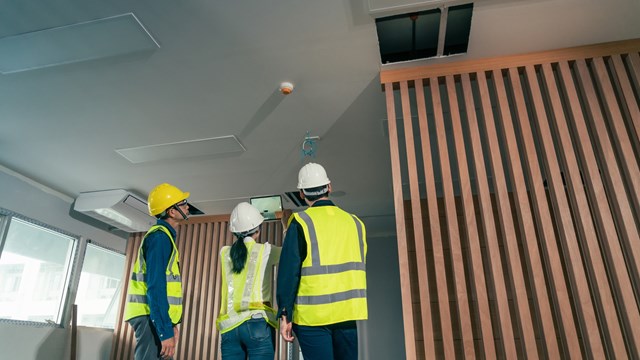
Despite being surrounded by both salt and fresh water, many cities and towns in South Florida face ongoing water management issues. According to the South Florida Water Management District, more than 7.7 million people—plus the environment, agriculture, businesses and visitors—rely on South Florida's limited water resources. Whether defined by shortages, or by challenges related to flooding or drainage, water issues are among the biggest that HOAs can face.
What Causes Water Shortages?
“We seem to have a series of extremes in South Florida,” says Randy Smith, a spokesman for the South Florida Water Management District. He cites that while South Florida’s rainy season, which runs from June to October, can bring in 55 to 60 inches of rain, the lack of rain during their dry season is what causes the problems. “During the dry season, there are only one to three inches of rain accumulated,” he says. “Droughts like these have been a problem for as long as we’ve been keeping records.”
Bill Worrall, vice president of the Continental Group in Hollywood says the last significant drought was in 2009 when most of the water restrictions were put into place.
“Most of them still carry today,” he says.
According to the SFWMD website, rainfall levels have been below average during the first months of this year’s dry season and were relatively low during the 2011 wet season, coming in at only 38 inches. Most areas of South Florida still haven’t seen any rainfall in 2012. Forecasts are predicting “drier-than-normal” conditions for this dry season, resulting in a water shortage warning for the District’s 16 counties.
Worrall cites an explosion in development that started in about 2004 as a problem that further aggravates the water shortages. He cites that in the past few years alone, 20 new high-rise developments have been announced, four of which where construction has already begun.
“All the new structures need cooling towers, consumption systems—they all need to run and consume water,” he says. “With this new development and the droughts, we need more water.”
Where Does The Water Come From?
According to Worrall and Smith, most communities use municipal water supply. Smith says that water from on-site lakes, ponds and wells is used primarily for landscaping.
Worrall says that the average water bill for a condo or co-op in South Florida is about $60 to $65 per unit per month or about $275,000 per year for the association as a whole, depending on the size of the complex. This cost can be cut down though, he says, by having an on-site water resource that pays off in the long run. He cites an instance where a manager of one upscale, luxury condo association installed his own well for irrigation.
“That reduces the municipal water bill and the cost of the well becomes a return on investment after five years or so when you realize the cost savings,” Worrall says. While there are no regulations on your own well, Worrall does cite that it’s very easy to dry up your own resource.
Effects of Water Shortages
The plain and simple answer to this is that there just isn’t enough water to go around. The more complicated answer includes how far this can go.
Julie Magaldi, Director of Condominium Assessment at The Continental Group cites an instance where one HOA built around man-made lakes experienced a loss of lake water during the droughts. Because the lake got so dry, the land started to erode and owners started losing physical chunks of their properties, she says.
Worrall says that shortages have led to many restrictions on how water can be consumed. For instance, HOAs are only allowed to run irrigation systems at off-peak hours, two to three days per week, he says. “You have to buy timers, clocks and valves for this,” he says.
Smith says that because of the limitations on water consumption, landscaping becomes something of an eyesore. “There’s dry grass everywhere, and lakes behind condos have low levels,” he says.
Worrall agrees saying that most communities have tried to adopt different types of vegetation that are drought-tolerant requiring less water and irrigation.
“The landscape definitely changes,” adds Magaldi.
Conservation
According to the Florida Department of Environmental Protection’s website, many believe water conservation to be the biggest environmental challenge faced by Floridians.
According to Smith, most communities will reduce the amount of water used for landscaping as a first measure, as that’s a big expense and uses a lot of water.
The SFWMD website suggests that instead of cleaning sidewalks with a hose, which can use 25 gallons in only five minutes, residents and owners should use a broom to get rid of unwanted debris and dust. They also recommend regularly checking for leaks that would waste water, and to cover pools when they are not in use to cut evaporation losses up to 70 percent.
Some other simple steps can include replacing toilets with ultra-low flush models or retrofitting them with low-flow flappers. Shower-heads should also be replaced with low-flow models. Smith says filling the dishwasher completely before running it is another conservation method that is being recommended.
Furthermore, the SFWMD suggests that owners and property managers should consider investing in efficient washing machines which can save up to 20 gallons of water per load and also save on energy. They suggest purchasing the new horizontal axis models which can save up to 40% of water used and 65% of energy.
Worrall says that he’s also seen communities that turn off car wash areas to cut water usage.
New Technology
“We have found innovative ways to mitigate water usage,” Worrall says about some new technologies that are available to assist with water conservation. He cites an example of where water is “submetered” aside from the main water meter.
According to the Miami-Dade County website, “The submeter program is offered to Water & Sewer Department (WASD) customers in order to obtain a reduction on the sewer portion of their bill. The submeter can be used for irrigation, cooling towers or when filling a swimming pool.”
American Water & Energy Savers, an organization based out of Boca Raton dedicated to water management and utility billing solutions, submetering “eliminates utility costs from the rent equation so the property stays more competitive. The owner can recover all if not most of the entire monthly utility bill thus increasing cash flow. Water submetering encourages residents to report leaks so you can take care of small problems before they become major repairs.”
Worrall points out that a difference between HOAs and condos and high-rises is how their water is paid for. HOAs don’t have cooling towers or HVAC systems so everyone ends up paying their own bill. “They have the liberty to pay as much as they see fit,” he says, which reduces water usage because nobody wants to overpay.
In contrast, residents of condos and co-ops pay a flat rate into one bill, so there is no tendency to be conservative. “They can shower all day long without consequence,” he says.
Worrall says that when condos implement the submeter program, the cost of cooling towers and HVAC systems is reduced by how much water is used because the owners become responsible for that part of the cost.
“The condos submeter the cooling tower (part of the HVAC system), pool, and irrigation systems in order to segregate this water usage from the domestic water usage,” he says, “thereby reducing the sewer cost component of the overall water bill.”
Condos and co-ops can also benefit from recycling water, Worrall says, so that the water doesn’t create any sewage.
According to the website of the University of Central Florida, this recycled water or “gray water” is water that is drained from baths, showers, washing machines and sinks and is reused for irrigation.
“Potable water used in showers, bathroom sinks and clothes washers is routed to an 85-gallon gray water cistern in the garage where it is treated according to Florida Building Code. This treated gray water flushes all of the toilets throughout the home. When the gray water cistern exceeds 85 gallons, it is diverted to the underground 5,178-gallon cistern solution outside the house, where it is mixed with green roof filtrate. Florida building code allows the water captured in a gray water reuse system to be disinfected by one of three choices such as chlorine, iodine or ozone.”
Worrall says the practice of recycling rainwater has been seen in new construction and has become popular in the past three years. Similar to the capture of gray water, rainwater is captured and is harvested for drinking water, irrigation, and air conditioning.
If condos and co-ops take part in any of these conservation methods, they could be eligible for certain write-offs or rebates. In Miami-Dade County, for instance, HOAs can go online and apply for an evaluation of their property and could get reimbursed for current and past conservation efforts, on-site inspection of irrigation systems, testing for sprinkler uniformity, training of landscape personnel in the principles of efficient irrigation, and water use efficiency recommendations.
“There are some great methods and tactics that we’re really excited about,” Worrall says. “We’re moving forward.”
Bernadette Marciniak is a freelance writer and a frequent contributor to The South Florida Cooperator.






Leave a Comment